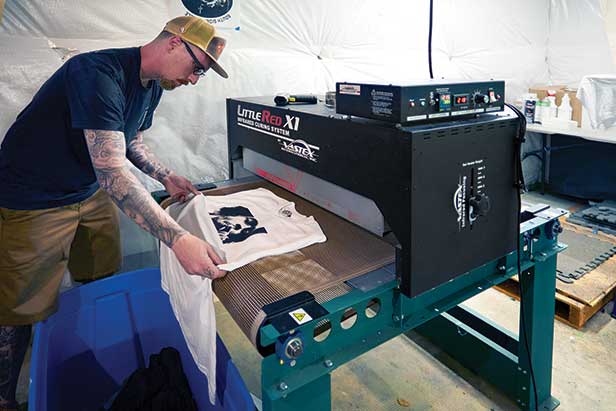Strategy December 01, 2020
Decoration Spotlight: Curing
The secret to quality screen printing comes down to this important process.
Robert Merrill’s screen-printing business, Cornerstone Printing Co. in Wilmington, DE, was born of his interest in skateboarding and skateboarding apparel.
He began with an inexpensive 6-color/4-station press to print T-shirts for local businesses, focusing on one- and two-color jobs with intricate designs and strong graphics. His attention to detail soon garnered the attention of family-owned businesses in the community.

Robert Merrill, owner of Cornerstone Printing Co. in Wilmington, DE, cures a screen-printed tee. The right setup for curing helps ensure a quality, long-lasting print.
He improved the quality through upgrades in curing of prints. Merrill first relied on a heat gun to flash shirts between colors and a heat press for the final cure, but both processes were time-consuming and unreliable. “Initially, I was spending 60 to 90 seconds flashing each shirt with the heat gun,” he says. “I would hover over the shirt and follow the ink lines at a distance of 3 inches for a few seconds in each area. If I held it too close or in one place for too long, it would burn the shirts.”
The heat gun also didn’t work well on all fabrics. “Switching to polyester required a change in temperature, but the heat gun wasn’t adjustable,” says Merrill. “This caused the T-shirts to shrink a little and fall out of registration when applying a secondary coat of ink.”
To improve quality and production speed, Merrill purchased a flash-cure unit from Vastex, providing the adjustability and consistency needed to prevent scorching, uneven drying and associated rejects. By pressing a foot pedal, the unit’s auto-flash option swings the infrared heater above the printed image and swings it away once the preset dwell time has elapsed, preventing over- or under-flashing of garments.
Merrill first relied on a heat press for the final curing of ink, but inconsistent temperatures affected the quality and appearance of prints. “The ink dried thick and heavy on the shirts and looked wrinkled after one or two washes – similar to a heat-transfer vinyl,” he says.
The turning point came when he had a problem with an order for 250 shirts from a local plumbing company. “The front-left chest area washed out because the ink hadn’t cured properly,” says Merrill. “That was the first time I lost a customer and it made me realize I needed a conveyor dryer.”
He purchased a LittleRed X1 infrared conveyor dryer, also from Vastex, with a 30-inch-wide belt, which doubled his output. “I’m able to feed garments at a rapid pace, allowing me to dry 150 single-color shirts in about four hours versus all night previously,” he says.
Merrill adds that the ability to reposition the heating chamber lets him easily create more space at the end to extend the cool-down period after curing. “This helps to prevent shirts from sticking together when they exit the conveyor belt and collect in a bin.”
Since he started using the conveyor dryer, Merrill says his customers have noticed an improvement in the look and feel of the finished product, and his business has grown through repeat business and word-of-mouth referrals.
His tattoo of the dryer sums up his enthusiasm: “The LittleRed has saved me so much time and energy that I had to dedicate a leg to it,” he laughs.
Coming full circle, he recently printed shirts for a startup skateboarding magazine to promote the publication. “I want to be there for everyone in my life who’s trying to achieve something and help them get the recognition they deserve,” he says.
Takeaways:
- Check with your screen printer to make sure they’re using professional equipment to ensure consistent print quality.
- Different fabric types require different cure temperatures. Too high of a temperature, for example, could cause a polyester T-shirt to shrink, resulting in an out-of-registration print when a second layer of ink is applied.
- Using a heat press rather than a heat tunnel to cure screen prints can affect print quality, making ink look wrinkled after only a few washes.
Mark Vasilantone is the president of Vastex International, a manufacturer of screen-printing equipment.
